Stay away from hogweed: What you need to know about these pesky and dangerous plants
Hogweed is harmful to humans and, experts say, the invasive species has become a growing problem in southern Ontario.
Dr. Nicola Mercer, the medical officer of health for Wellington-Dufferin-Guelph, called the pesky plant a real danger that’s “a lot worse than poison ivy.”
“It can cause severe burns. Sometimes up to third-degree burns,” she explained.
Touching hogweed can also result in inflammation or blisters, which you might not notice right away.
“I’ve been burned a couple of times [and] didn’t know for three days,” John Kemp, the founder of the Giant Hogweed Mitigation Project, said. “Then, I get blisters.”
The best way for people to protect themselves, he added, is by knowing what hogweed looks like and where it grows.
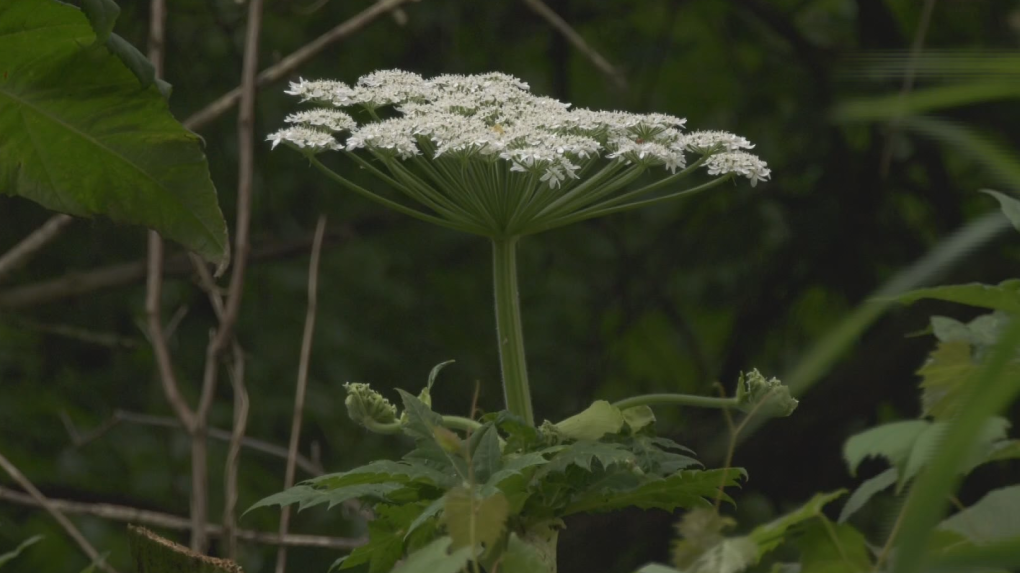 Hogweed plant at Schneider Park in Kitchener, Ont. on July 3, 2024. (Dan Lauckner/CTV News)
Hogweed plant at Schneider Park in Kitchener, Ont. on July 3, 2024. (Dan Lauckner/CTV News)
The Grand River Conservation Authority said the plant has been spotted at Belwood Lake near Fergus, St. Jacobs, Kitchener, Guelph and Cambridge.
While an increase was initially noted a few years ago, the GRCA said haven’t seen a spike – so far – this summer.
The City of Kitchener, meanwhile, is working with the Region of Waterloo to monitor and manage the plants on their property.
At some locations, like the Schneider Park trail, the plants have been marked with orange paint.
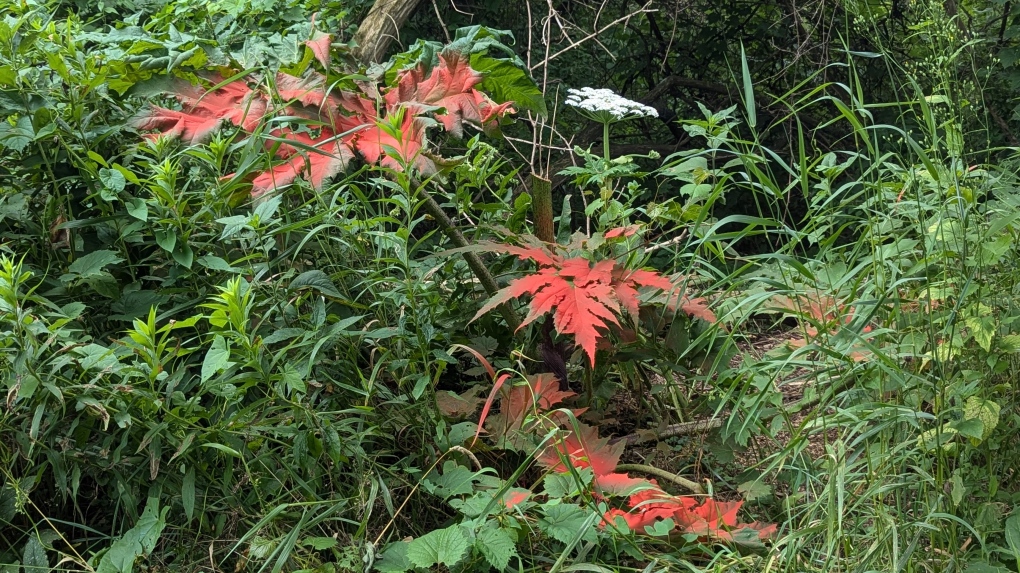 Hogweed plants, marked with orange paint, at Schneider Park in Kitchener, Ont. on July 3, 2024. (Dan Lauckner/CTV Kitchener)
Hogweed plants, marked with orange paint, at Schneider Park in Kitchener, Ont. on July 3, 2024. (Dan Lauckner/CTV Kitchener)
In a statement to CTV News, the city said it is “prioritizing areas where the plants’ proximity to existing city trails and parks poses a safety risk.”
In terms of long-term management, Kemp said there’s no simple solution.
“We’re going to have to learn to live with it because there isn’t sufficient legislation or motivation to remove it. We need to get the policymakers to loosen their purse strings and change the rules to make an integrated approach to remove it.”
What is hogweed and where can you find it
Giant hogweed originates from southwest Asia.
Now common in southern and central Ontario, the plant is often seen growing along roads, ditches and streams, as well as fields and woodlands.
Kemp said he keeps an eye on the Grand River watershed, and specifically, the area between Waterloo Region and Brantford.
Health hazards
Hogweed sap contains toxins that are harmful to human skin.
Some of the symptoms include:
- Rash
- Painful blisters
- Severe burns (especially if exposed to sunlight)
- Purplish scars
- Temporary blindness (if it gets in your eyes)
“In [the] worse cases, people are hospitalized for weeks,” Kemp explained. “It can leave a mark for years, or your skin comes back slightly pigmented.”
“Often, you don’t notice right away,” Mercer said, adding that symptoms can show up 48 hours after exposure.
Treating hogweed burns
“There are some treatments, but the treatments are not great,” Mercer admitted.
If you get hogweed sap on your skin, you should act immediately.
“You have to wash it with soap and water,” she said. “If you have inflammation and if you have a bad burn, you can still sometimes get what we call photosensitization.”
That means the affected skin can become sore, itchy and even change its pigment when exposed to direct sunlight.
“Keep the area covered and contact a health professional right away,” Mercer advised.
If the sap gets into your eye, flush it out with water.
Avoiding these pesky plants
Kemp shared his advice for anyone heading outside this summer.
“Stay on the trail,” he said. “If you’re going off trail then you’re going to have to wear shoes and socks and long pants. That’ll protect you from poison ivy, stinging nettles and giant hogweed.”
When he’s checking out local trails for the plant, he comes prepared.
“We have to wear hazmat suits,” Kemp explained.
 John Kemp, founder of the Giant Hogweed Mitigation Project, stands beside one of the plants on July 5, 2024. (Tyler Kelaher/CTV News)
John Kemp, founder of the Giant Hogweed Mitigation Project, stands beside one of the plants on July 5, 2024. (Tyler Kelaher/CTV News)
Similar species
Hogweed can be confused with other similar-looking species.
The GRCA said it’s not uncommon for people to mistake the plant for its look-a-likes.
Those include: Cow parsnip, Purplestem angelica, Woodland angelica, Valerian, Lovage and Queen Anne’s Lace (or wild carrot).
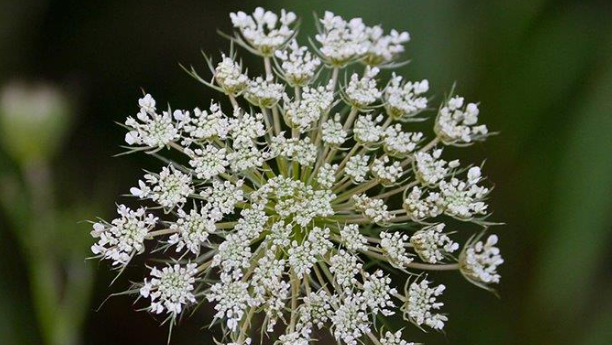 Queen Anne's Lace.
Queen Anne's Lace.
How you can tell the difference
Hogweed will be larger than other species and, once fully matured, can grow up to 5.5 metres tall in the right conditions.
“[They’ve got] pointy leaves, three or five points, with a hairy stem and there’s purple blotches on the stem,” Kemp explained.
Unlike Queen Anne’s Lace, hogweed will have more widely-spaced flower clusters. Those can get as big as one metre wide.
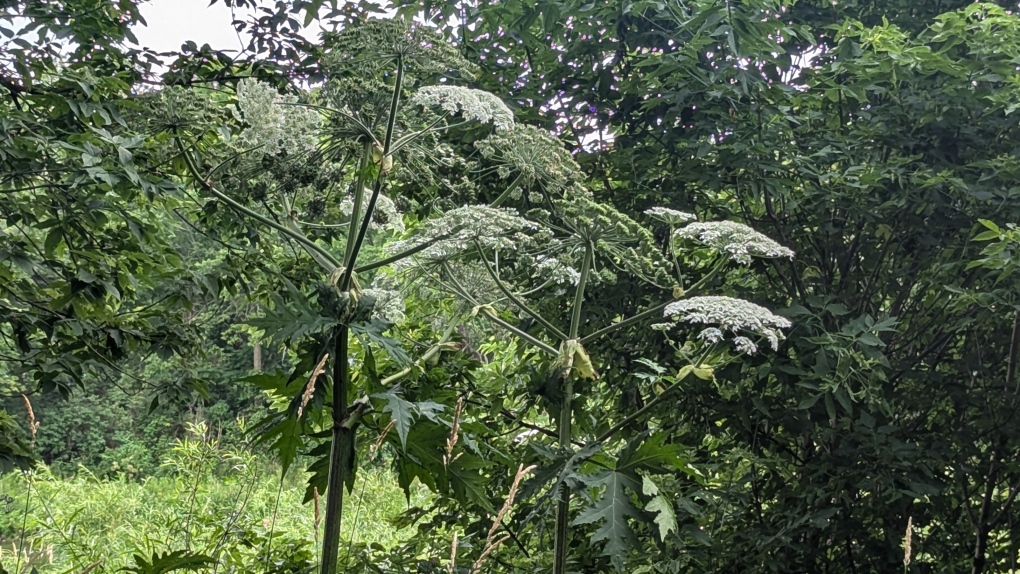 Hogweed plants at Schneider Park in Kitchener, Ont. on July 3, 2024. (Dan Lauckner/CTV Kitchener)
Hogweed plants at Schneider Park in Kitchener, Ont. on July 3, 2024. (Dan Lauckner/CTV Kitchener)
Why hogweed is so hard to get rid of
Once germinated, seeds are viable for up to 15 years.
According to the province, the plants can produce between 50,000 and 120,000 winged seeds. If they make it onto the surface of a moving body of water, those seeds can float for days and travel a far distance away.
What to do if you find hogweed
“If you do have [hogweed] on your property, or if you see it on a trail or in a park, we must identify it and have a safe way to remove it because it just can’t be pulled up,” Mercer explained.
Experts recommend hiring a professional to remove hogweed to ensure proper protection is used and extra efforts are made to limit the spread of its seeds.
They also suggest removing the plants in late April or early May, as they’re easier to dig up and are more susceptible to herbicides.
If you’re doing the work yourself, experts say it’s essential to wear protective clothing. That includes waterproof gloves, long-sleeve shirts, pants and eye protection. They even suggest wearing a “spray suit” over your clothes.
Once the hogweed has been safely disposed, experts say your clothes should be removed carefully so the sap doesn’t get on your skin. Experts recommend washing your gloves first, then taking of the spray suit or clothes, then washing the gloves again before taking them off. Once all of that has been done, you can remove any protective eyewear. Clothes should be washed immediately.
When attempting to remove hogweed, you’ll need to get all the roots, which can grow up to a metre deep. If any are left behind, they can regrow. Experts suggest covering the dug up area with black plastic to smoother any new root growth.
Disposing hogweed plants
Once the plants have been dug up, it’s time to get of them.
If they don’t have flowers, experts recommend leaving them out to dry before disposing of them.
“Once the sap’s dry it’s not poisonous anymore,” Kemp explained.
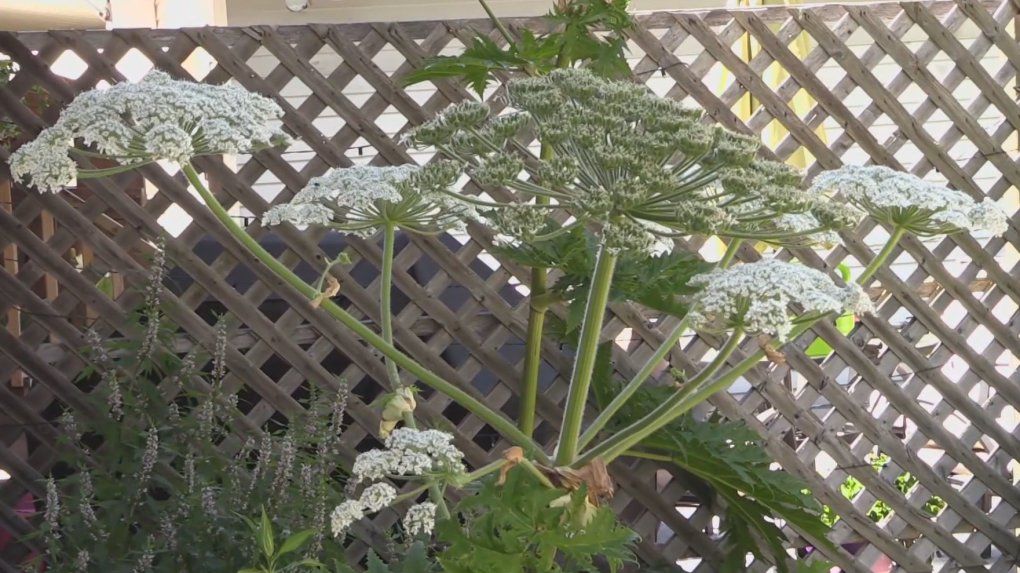 A hogweed plant in an undated image.
A hogweed plant in an undated image.
Removing plants with flowers, meanwhile, is a little more complicated. Flower clusters should be removed first to prevent seed spread, but if the flowers have already changed from white to green they could be harder to remove.
The province says herbicides, like glyphosate, can also be used.
As for disposal, hogweed plants shouldn’t be burned or composted.
The province suggests calling your municipality to find out if dried out hogweed plants are accepted at your local landfill.
What else you can do
If you find hogweed growing in your yard or community, contact the Invading Species Hotline at 1-800-563-7711 or report online here. www.invadingspecies.com/Report.cfm
For GRCA properties, email the agency’s Land Management Department.
Sightings can also be reported directly to your municipality. The GRCA shared the following contact information:
- Brant County: Weed inspector at 519-449-2451
- Dufferin: Dufferin County Building Services - 519-941-2816 ext. 2700 or email building@dufferincounty.ca
- Guelph: Report an invasive species. Contact Public Works at 519-837-5626 or email parks@guelph.ca
- Haldimand: Contact the bylaw enforcement staff at 905-318-5932
- Halton: By-law enforcement officers and area weed inspectors.
- Hamilton: If you find giant hogweed, call 905-546-2489
- Oxford: Weed inspector at 519-539-9800, ext. 3132.
- Perth: Weed inspector at 519-291-2236.
- Region of Waterloo: In North Dumfries, Wellesley, Wilmot and Woolwich townships contact the Region's Area Weed Inspectors at 519-575-4400. In Kitchener, Cambridge and Waterloo contact city hall.
- Wellington: Weed inspector at 226-962-4007
-- With reporting by CTV's Tyler Kelaher
CTVNews.ca Top Stories

5 rescued after avalanche triggered north of Whistler, B.C. RCMP say
Emergency crews and heli-skiing staff helped rescue five people who were caught up in a backcountry avalanche north of Whistler, B.C., on Monday morning.
Quebec fugitive killed in Mexican resort town, RCMP say
RCMP are confirming that a fugitive, Mathieu Belanger, wanted by Quebec provincial police has died in Mexico, in what local media are calling a murder.
Bill Clinton hospitalized with a fever but in good spirits, spokesperson says
Former President Bill Clinton was admitted Monday to Georgetown University Medical Center in Washington after developing a fever.
Trump again calls to buy Greenland after eyeing Canada and the Panama Canal
First it was Canada, then the Panama Canal. Now, Donald Trump again wants Greenland. The president-elect is renewing unsuccessful calls he made during his first term for the U.S. to buy Greenland from Denmark, adding to the list of allied countries with which he's picking fights even before taking office.
UN investigative team says Syria's new authorities 'very receptive' to probe of Assad war crimes
The U.N. organization assisting in investigating the most serious crimes in Syria said Monday the country’s new authorities were “very receptive” to its request for cooperation during a just-concluded visit to Damascus, and it is preparing to deploy.
Pioneering Métis human rights advocate Muriel Stanley Venne dies at 87
Muriel Stanley Venne, a trail-blazing Métis woman known for her Indigenous rights advocacy, has died at 87.
King Charles ends royal warrants for Ben & Jerry's owner Unilever and Cadbury chocolatiers
King Charles III has ended royal warrants for Cadbury and Unilever, which owns brands including Marmite and Ben & Jerry’s, in a blow to the household names.
Man faces murder charges in death of woman who was lit on fire in New York City subway
A man is facing murder charges in New York City for allegedly setting a woman on fire inside a subway train and then watching her die after she was engulfed in flames, police said Monday.
Canada regulator sues Rogers for alleged misleading claims about data offering
Canada's antitrust regulator said on Monday it was suing Rogers Communications Inc, for allegedly misleading consumers about offering unlimited data under some phone plans.
































